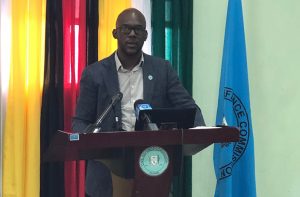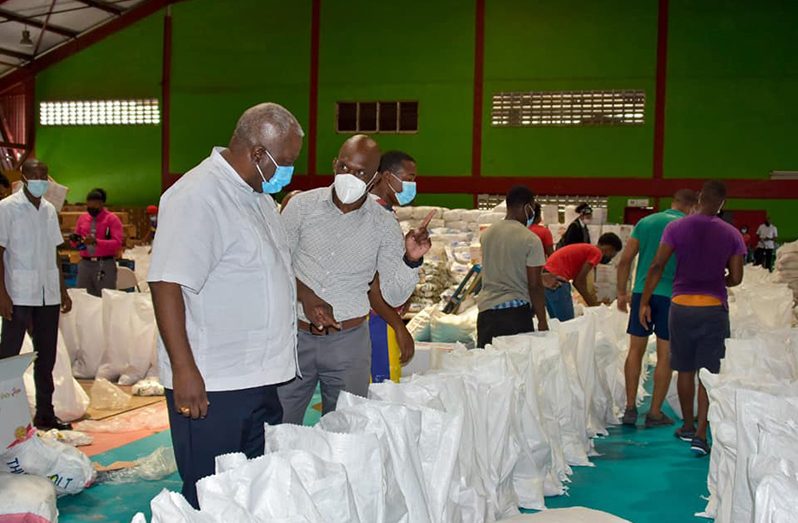–as more than 6,900 households affected, 54 persons remain in shelters
AS countrywide flooding continues, the Government of Guyana is prioritising the safety and wellbeing of those affected.
To this end, the administration has intensified its distribution of food and sanitary supplies to bring relief to flooded households and persons who have been relocated to shelters.
On Wednesday, Prime Minister, Brigadier (Ret’d) Mark Phillips, visited the National Gymnasium on Mandela Avenue, Georgetown, where truck-loads of supplies are being packaged for distribution by ranks of the Guyana Defence Force (GDF), with critical support from civilian volunteers.
The Prime Minister, accompanied by Director-General of the Civil Defence Commission (CDC), Lieutenant Colonel Kester Craig, expressed appreciation to those involved in the important exercise.

Colonel Craig, at a press conference later in the day, outlined that so far, in excess of 6,900 households across the country have been affected by the ongoing floods.
Specifically, he said that 1,500 households have being affected in Region Two, while 600 homes in Region Three have shared a similar fate.
Approximately 2,800 households were flooded in Region Six, followed by 1,000 households in Regions Nine and 10, respectively. So far, the government has distributed in excess of 15,000 hampers to affected families.
Meanwhile, Craig told media operatives present at the CDC’s Thomas Lands, Georgetown headquarters, that technical teams have been dispatched across the country to conduct further rapid assessments which would aid in painting a clearer picture of the realities being experienced on the ground.
He confirmed that the flood, which is in its third week, has resulted in notable losses of crops and livestock, as well as infrastructural damages. Reports are that water levels in some areas have surpassed 12 feet.
The CDC Head was unable to estimate the economic costs of the floods, but said that once the ordeal has ended, technical personnel would be recruited and support will be garnered to conduct a socio-economic assessment. A similar exercise was executed following the infamous 2005 floods, which devasted mainly the coastland.
Subsequent to the 2005 floods, as a solution mechanism, the Northern Relief Channel was constructed at Hope/Dochfour, East Coast of Demerara. This $3.6 billion infrastructure is said to be the reason for Region Four being spared from the devastating floods.
Authorities, including President, Dr Irfaan Ali, have committed to ensuring similar projects are replicated throughout the country, to safeguard residents in other regions, especially Region 10, which has been most affected.
SHELTERS
Colonel Craig told reporters that so far, 54 persons in Regions Nine and 10 have been utilising the availability of government shelters, which have been established at a number of public buildings. He said that once the floods persist, the shelters will remain activated. “…until they can return to their homes.”
Although he could not report on the COVID-19 surveillance, testing and vaccination efforts in the flooded regions, Craig related that shelter managers have been ensuring strict adherence to national health protocols.
He related too that so far, the CDC has been able to adequately respond to the demands for flood-relief items; however, increased support is still needed.
In addition to corporate Guyana and members of the Private Sector Commission, the CDC has also received a commitment from the Caribbean Disaster Emergency Management Agency (CDEMA), which is preparing to send 500 cots (camp beds).
AN EYE-OPENER
Meanwhile, Colonel Craig said that even though 2005 was a major eye-opener, some of the measures taken after the floods were not sustained. He pointed specifically to the fact that the effects of heavy rainfall and high tides have been exacerbated by poor maintenance of drainage components in certain regions.
Asked what role the CDC will be playing in rectifying infrastructural challenges, Craig said that this can be done via the National Disaster Risk Management platform, which meets to identify risk reduction and mitigation efforts. This forum, according to the CDC official, has two levels – policy and technical. The policy level, he said is chaired by Prime Minister Phillips.
Craig also pointed to the need for Guyana to invest in programmes and policies that seek to reduce and mitigate the impact of climate change.
“Key for us in Guyana is that we are living in a time when the whole world is affected by climate change, and we must start to take adaptation measures,” Craig said.
He noted that in addition to increased floods and the intensity of rainfall, high winds and earthquakes being experienced in Guyana are all worrying effects of climate change. Craig related the importance of investments to mitigate the impact of climate change, since it is often less expensive than activating response operations.
In concluding, he said that the administration’s focus now is on maintaining the safety and wellbeing of all Guyanese, especially those affected by the floods.



.jpg)









